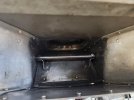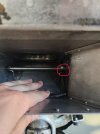David Lunn
Filing Flight Plan
- Joined
- Nov 5, 2021
- Messages
- 3
- Display Name
Display name:
Dave
After taking a close look inside the air box on my 182Q I noticed when I press on the carb heat flapper one of the two rivets that attaches it to the shaft is broken. The broken rivet is circled, unless you press on it, it looks to be in the normal position although I suspect in flight the air flow deflects the broken side down slightly.
Do I need to order a new air box/rebuild this one or is it as simple as re-riveting the right side to the shaft (just not sure if there is space to install a rivet inside the box)? My mechanic hasn't run into this before and isn't quite sure. Everything else about the air box is in good shape so I'd prefer a quicker fix but want it to be done properly and to last.
Thanks you!
Do I need to order a new air box/rebuild this one or is it as simple as re-riveting the right side to the shaft (just not sure if there is space to install a rivet inside the box)? My mechanic hasn't run into this before and isn't quite sure. Everything else about the air box is in good shape so I'd prefer a quicker fix but want it to be done properly and to last.
Thanks you!















